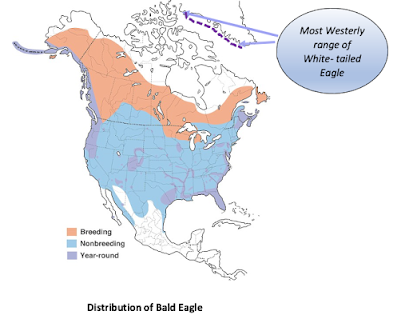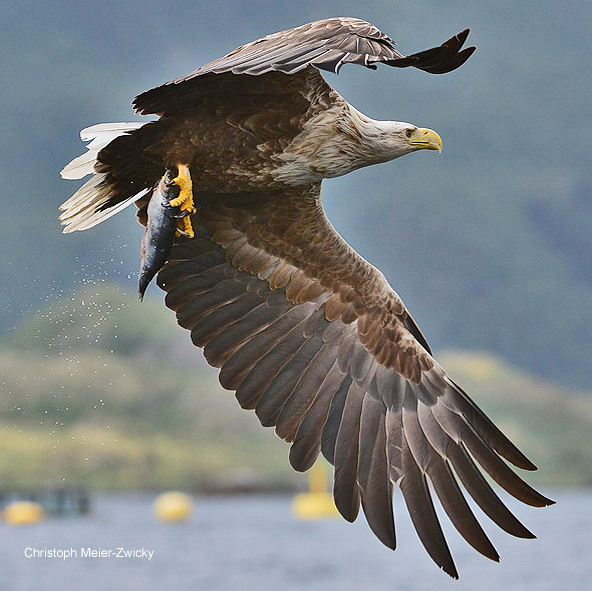A tale of two Eagles
 |
1. White-tailed Eagle © Christoph Meier - Zwicky |
British reintroduction
In the 18th century White-tailed Eagle (WTE) was widespread in Scotland, and Ireland bred and once upon a time, in England and the Isle of Man. By the 19th century, 100 eyries were known in Britain with 50 in Ireland.
The species became extinct in the UK, not due to loss of habitat, but because of persistent continual persecution by gamekeepers, fishery owners, egg and skin collectors, and the like. The general view of society and the public at this time was to control raptors as they were considered a threat to sheep farming and the numbers of game birds.
The pressure continued until the19th century when the species completely disappeared from England. It hung on a little longer in Ireland, but by 1900 only a few pairs remained on the British Isles - all in Scotland. The last breeding pair in Scotland was on the Isle of Skye in 1916 followed by the very last British bird shot in Shetland two years later.
Fortunately, times have changed
Although quite common globally, WTE is considered of (Least Concern) in the IUCN red list category. The UK has had several reintroduction schemes beginning when there was serious decline. The first of these raptors, also known as Sea Eagles, were reintroduced to the Isle of Rum in 1975 and later to Wester Ross. These birds have established an increasing breeding population on the west coast of Scotland. A third Scottish reintroduction of 85 birds on the east coast between 2007 and 2012, generated a link between the two northern Scottish populations.
To the delight of many a lockdown birdwatcher...
White-tailed eagles have been released on the Isle of Wight on the southern coast of England.Birders confined to barracks, due to the Coronavirus pandemic, condemned to spend their days staring at the sky, will occasionally see a very large raptor in its distinct lap lap glide flight often accompanied by a squabble of Gulls. In early January 2021 a Juvenile was seen in Salisbury, Wiltshire flying not to high above the rooftops accompanied by such a Gull flock, to the delight of many a caged birder...myself included!
 |
| 2. White-tailed Eagle © Christoph Meier - Zwicky |
The legal protection of White-tailed Eagles was a slow development initiated by Iceland in 1913 and finalised by Greece in 1973. In what was probably the last safe stronghold in western Europe - Norway began protecting them in 1968. Protection from direct persecution was granted by the 1950's while the use of DDT was banned in the 1970's.
3. White-tailed Eagle © Christoph Meier - Zwicky
A tale of two eagles continues (tap)
The Eagle cousins have been captivating science since ornithology began and remind us that evolution is always and continually happening all around us.
WTE are widely distributed globally. In the extreme west of their range in SW Greenland, it is considered by some a subspecies groenlandicus.
The cousins are geographically separated, with Bald Eagle populations occupying the North America continent up to the northern end of its range in Newfoundland, Canada (Map.2), and White-tailed Eagle groenlandicus residing just across the Labrador Sea in Greenland.
The cousins are geographically separated, with Bald Eagle populations occupying the North America continent up to the northern end of its range in Newfoundland, Canada (Map.2), and White-tailed Eagle groenlandicus residing just across the Labrador Sea in Greenland.
Another fact to whet your appetite; the White-tailed has a significantly larger wing chord (width) and average wingspan. Conversely, the Bald Eagle usually has a longer tail length resulting in a longer total length than the White-tailed Eagle.
Size comparisons by weight
Bald Eagle: male 3.68-4.86 kg female 4.64-6.41 kg mean 4.90 kg
The Bald Eagles has fascinated the American nation for centuries and become a symbol of bravery and dignity - traits attributed purely from its noble appearance. 'Truth is, it is just as inclined to pilfer its lunch as any other wild creature. These values are ours not the Eagles'.
Superspecies(common ancestry)
Of the ten Genus Haliaeetus species (Sea and Fish Eagles), these two (Bald and White-tailed Eagles) are obviously extremely close and from the same original species origin.
Leading from allopatric speciation, groups stemming from common ancestral stock are known to evolve into separate species due to a prolonged period of geographical separation, i.e., continental plate movement over millennia. Ancient DNA sequences from 3,500 year old Eagle fossils from the Hawaiian Islands represent an extinct, long-term, endemic lineage of Haliaeetus, believed to illustrate 100,000 years of that raptor's dominance there.
Let's examine and compare Bald Eagle Haliaeetus leucocephalus and White-tailed Eagle Haliaeetus albicilla images:
Same pale headed individuals of White-tailed are, in fact, very similar to Bald Eagle.
Are there instances of hybridisation between the two when/if they meet?
Apparently they don't out in their natural range.
 |
| 4. Bald Eagle © Richard Anderton This individual seen near the road on power pylons approaching the visitors center Merritt Island National Wildlife Florida USA Bald Eagle (above) 4,6 and 7 |
White-tailed Eagle 1.2 and 5 photographed in Denmark
 |
| 5. White-tailed Eagle © Christoph Meier - Zwicky |
 |
| 6. Bald Eagle © Richard Anderton |
Allopatric speciation is the drifting apart of two populations of the same species which eventually become so isolated from each other, giving rise to a new species, occupying the same ecological niche.
 |
| Bald Eagle © Richard Anderton |
 |
| Map.2 |
 |
| 7. Bald Eagle © Richard Anderton |
WTE pictures are provided by Dr. Christoph Meier - Zwicky, of Switzerland taken in Denmark
Bald Eagle pictures from the USA by the author





No comments:
Post a Comment